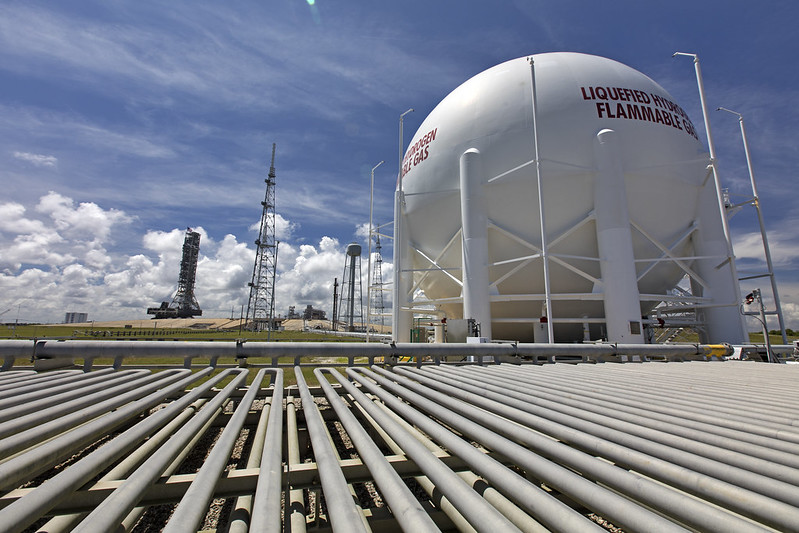Key hydrogen projects are collapsing, but that isn’t stopping developers from begging for more taxpayer money and support from the Alberta government.
And it seems like the industry’s lobbying is paying off.
The province is now pursuing an ill-conceived idea to allow hydrogen to be mixed with natural gas for home heating. Hyping the increasinglydebunked “hydrogen revolution” might be politically expedient for Alberta Premier Danielle Smith and her friends in the oil patch, but it is terrible public policy that ignores some fundamental properties of the lightest element known to science.
Alberta tabled a bill last month allowing utilities to blend up to 5 percent hydrogen with natural gas (mostly methane) that is delivered to homes and businesses. “Hydrogen presents an enormous opportunity and we want to ensure our province can remain a global leader,” said Alberta Utilities Minister Nathan Neudorf at the time.
However, experts warn that blending hydrogen with heating gas provides minimal climate gains, increases the rate of pipeline leakage, and is more dangerous than methane alone.
Toronto-based chemical engineer Paul Martin has written extensively on the subject including a recent peer-reviewed paper in which he concluded that hydrogen blending “offers only a small reduction in greenhouse gas emissions” while creating “serious safety and environmental risks.”
When asked by Desmog why he thinks the Alberta government might be moving towards mixing hydrogen with methane for heating he suggested the following possible reasons: “desperation, bad advice, lobbying?”
To Martin this strategy is less about actually reducing climate impacts and more about providing cover for the oil patch. “They desperately need to pretend that the Alberta economy is not toast in the decarbonized future,” he said in an interview. “This has nothing to do with reducing GHG emissions.”
A false solution
One of the first problems according to Martin is that hydrogen has a much lower energy content than methane, meaning the 5 percent portion of hydrogen will provide only 1.5 percent of the heating capacity of the total mixture. Customers would therefore need to burn more gas (and money) to heat their homes at the same price. This also means that the maximum resulting carbon reduction will only be 1.5 percent, assuming that the source of the hydrogen is entirely emissions-free.
However, the government’s own documents reveal that 80 percent of Alberta’s hydrogen is “unabated”, or derived directly from fossil fuels without any emissions mitigation. This process releases up to 10 kg of CO2 for every kg of hydrogen produced. The other 20 percent of hydrogen sources include some kind of carbon capture that in theory reduces that climate impact to 6.5 kg CO2 per kg of hydrogen.
So-called green hydrogen made by splitting water using clean electricity like wind or solar is so uneconomic it is virtually non-existent. In Alberta, the projected cost of producing hydrogen from wind-powered electrolysis is 8 times higher than chemically splitting natural gas and dumping the resulting CO2 in the atmosphere.
Using existing gas pipes for delivering hydrogen bumps into a series of physical limitations. To deliver the same amount of energy as methane gas, hydrogen needs to be pumped at a rate three times higher than methane. This results in higher rates of leakage of both hydrogen and methane, which is 28 times more damaging as a greenhouse gas than CO2. Hydrogen also requires 13 percent more energy to be compressed than natural gas and loses 10 percent more pressure per unit length of pipe compared to gas, adding additional expenses and emissions.
Because hydrogen burns hotter than methane, it creates higher amounts of indoor nitrogen oxides that have been linked to increased rates of childhood asthma. Hydrogen is notoriously leaky and is itself a powerful greenhouse gas because it increases the lifespan of methane in the upper atmosphere.
Poor economics
Even under ideal conditions, burning hydrogen is an incredibly expensive way of reducing greenhouse gas emissions. Assuming a very optimistic future scenario where green hydrogen production drops to $3 per kilogram and is used to displace natural gas, the resulting emission reductions add up to an eye-watering $350 per tonne. If distribution costs are also included, those costs climb to about $700 per tonne. Compare that to GHG reductions from fixing fugitive emissions (~$10/T) or subsidizing efficient appliances (~$150/T), burning hydrogen as a fuel is remarkably cost-ineffective climate strategy.
What about piping pure hydrogen through existing gas lines? There are many reasons why this would be a terrible idea. Existing appliances, furnaces and gas meters are all designed for methane and would need to be modified or replaced at hydrogen concentrations above 20 percent.
Hydrogen can also accelerate stress fractures in gas mains through a process called pipe embrittlement, worsening an already widespread problem. Explosions from natural gas pipeline failures average about 30 per year in the US, causing over 11 fatalities and $350 million in damages annually. Hydrogen is also flammable over a far wider concentration range than methane and is therefore far more dangerous to burn indoors. A study from the UK predicted that substituting pure hydrogen for methane would increase household gas explosions fourfold.
‘Predatory delay’
If including hydrogen with methane is such a money-losing climate failure, why is the government of Alberta doing it?
A recent report on pension funds may provide a clue. It documents how nine Canadian pension funds – including Alberta’s AIMCO – have ownership stakes in almost 350,000 km of natural gas lines that will become worthless if homeowners switch to cheaper alternatives like heat pumps that produce far lower emissions.
To Martin the government and industry funding of hydrogen is an example of “predatory delay,” a deliberate attempt to block true climate solutions while wringing as much profit as possible out of the current unsustainable status quo.
“This has nothing to do with decarbonization,” he said “It’s a predatory delay strategy that’s intended to allow the shareholders of gas infrastructure to pretend that they have a future post decarbonization. That’s what it’s about.”
Subscribe to our newsletter
Stay up to date with DeSmog news and alerts






